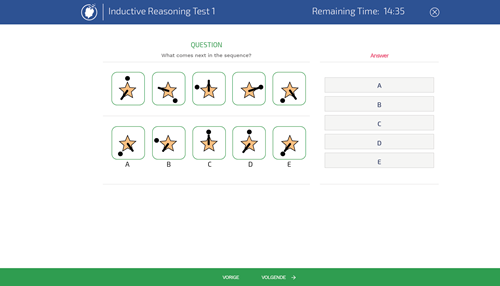- 206 Aptitude Tests
- 3281 Aptitude Test Questions
- One-off Payment
Tips to Pass an Inductive Reasoning Test
What is an Inductive Reasoning Test
Some recruiters chose to employ inductive reasoning tests for evaluating the analytical abilities that you as a candidate possess, your capability of establishing logical relationships, and identifying patterns and finding a solution based on the same. They help to indicate your adaptability work with unfamiliar data and also your decision-making capabilities.
Unlike other tests that contain numerical and written language, the inductive reasoning tests usually make use of figures, images and patterns. The answer may be deduced by recognizing the relationship between these figures or patterns through analyzing their appearance and characteristics.
Inductive reasoning exercises are commonly used as a part of psychometric tests for providing admission to graduate courses or in assessment centers of some companies for hiring new employees.
Example of what an Inductive Reasoning Test test looks like:

Acing the Inductive Reasoning Test
Knowledge of a few tips can help you score well in the inductive reasoning tests.
- Divide and Analyze the Patterns
Instead of analyzing the shapes and patterns as a whole, you should divide them into specific segments based on their characteristics. Each segment can be taken up one at a time and compared across all the given figures. The change in the position and dimensions of the segment under consideration should be analyzed, and the flow of pattern should be recognized. Each figure from the given answer choices should be reflected upon and every one of its segment should be compared with the flow of the given pattern. The figure of which every segment conforms to the flow of the pattern will be the ideal fit. Analyzing the patterns and figures as a whole can be confusing and difficult to keep track of, leading to errors and time wastage.
- Become Accustomed to Test Format
A test taker should be aware of the format of the test. The total number of questions that they will be required to answer, the number of distinct sections in the test, the total time duration that will be assigned to answer the test and the types of patterns that may be given in the test for analysis should be known beforehand. This information may help you devise a strategy on how to go about the test, how much time to assign each question, when to leave a difficult question and if you will need to spare some time for revisiting the unanswered questions.
- Time Allocation and Management
The inductive reasoning tests are usually meant to be completed within a designated amount of time. The total time available should be appropriately divided among all sections and questions with some spared for revisiting questions that were left unanswered. If you get stuck on a question, once the time spent on it exceeds the assigned limit, you should move onto the next question. For a better score, you should focus on answering more questions and not on answering the difficult ones, as all the questions carry equal marks. A constant vigil should be maintained on the time left and the time allotted for each question should be adjusted accordingly.
- Regularly Practice Before the Test
The best boost that you can give to your scores and chances of acing the test is regular practice. There are multiple mock tests available online. Timing the tests that you take and gauging your performance against the clock every day may help you strive for speed improvement. You will also get comfortable with the format and process of the test, thus eliminating any unnecessary excitement on the test day.
- Use Elimination Techniques
For arriving at the correct pattern, instead of focusing on recognizing the correct figure, you may use an elimination technique. A reverse methodology can be employed wherein the given figures should be analyzed with the purpose of rejection by identifying their segments that do not conform to the required pattern flow. This technique helps save time as each one of its segment must be analyzed for passing a pattern; while for rejecting it, only the most deviating ones should be recognized. Also, if one answer choice has been rejected, other answer choices that have the same segment reflecting the same deviation may also be ignored.
- Be Careful of Mirroring and Confusing Patterns
In the given answer choices, to confuse you, there may be a pattern that is correct and there may be another choice that will be the mirror image of the correct one. As the answer options are generally rotated, it may be hard to recognize the difference between the two. There may also be other patterns in the answer choices similar to the correct pattern except for one or two deviating segments. These minute differences are usually hard to identify and so careful examination and analysis of the patterns are required.
- Co-Align the Patterns Mentally
Another trick to solve the patterns quickly is co-aligning them mentally. This can be done by examining each answer option and then rotating it in mind so that it has the same side along a given axis, as the figures in the main pattern. This may make the process of comparison and analysis easier and help solve the question faster.
- Learn Test Question Construction
The best way to answer a question correctly in an inductive test is finding out how it was constructed. The answer choices are usually made by modifying segments of the correct figure. The modifications may be done by rotating the figure around its center axis or rearranging some of its elements. Learning how these questions are created can help you find the right pattern from given answer choices faster.
How can Assessment-Training.com help you ace your Inductive Reasoning test?
Assessment-Training.com is your number 1 online practice aptitude test and assessment provider. Our aim is to help you ace your assessment by providing you practice aptitude tests that mimic the tests used by employers and recruiters. Our test developers have years of experience in the field of occupational psychology and developed the most realistic and accurate practice tests available online. Our practice platform uses leading-edge technology and provides you feedback on your scores in form of test history, progress and performance in relation to your norm group.
Check out our tailor-made Inductive Reasoning Test Pack to fully prepare you for your assessment.
The Assessment-Training.com data science team found that through practice, candidates increased their scoring accuracy and went into their assessments more confident. Remember, you need to practice to make sure you familiarize yourself with the test formats, work on your accuracy and experience performing under time-pressure.
Inductive Reasoning
- 12 Tests
- 144 Questions
- One-off payment
- 206 Aptitude Tests
- 3281 Aptitude Test Questions
- One-off Payment
Inductive Reasoning
- 12 Tests
- 144 Questions
- One-off payment
